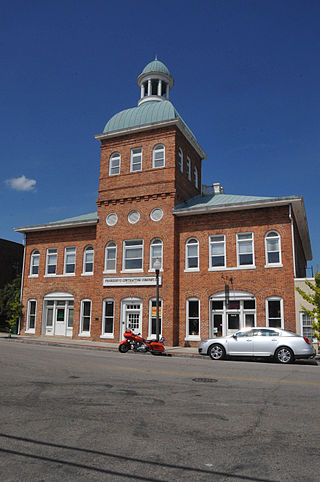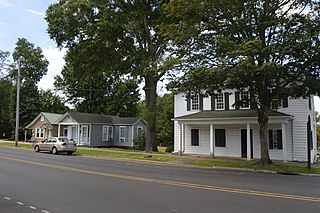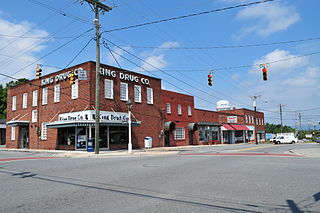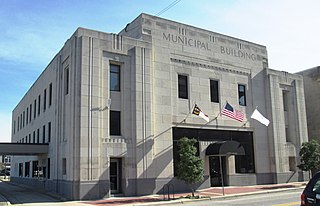
Halifax Historic District is a national historic district located at Halifax, Halifax County, North Carolina, US that was listed on the National Register of Historic Places in 1970. It includes several buildings that are individually listed on the National Register. Halifax was the site of the signing of the Halifax Resolves on April 12, 1776, a set of resolutions of the North Carolina Provincial Congress which led to the United States Declaration of Independence gaining the support of North Carolina's delegates to the Second Continental Congress in that year.

Riverside Industrial Historic District, also known as Asheville Wholesale District, is a national historic district located at Asheville, Buncombe County, North Carolina. The district encompasses 27 contributing buildings and 1 contributing structure in a predominantly industrial section of Asheville. Notable buildings include the Orpheus and Bertha Keener House, American Feed Milling Company, Italianate style Carolina Coal & Ice Company, Asheville Cotton Mill Cloth Warehouse, Standard Oil Company complex, and Farmers Federation Building.

Catawba Historic District is a national historic district located at Catawba, Catawba County, North Carolina. The district encompasses 48 contributing buildings and 1 contributing structure in the rural village of Catawba. It contains 19th century farmhouses and tracts of farmland with scattered outbuildings as well as village residences and a small commercial district. The district includes notable examples of Gothic Revival, Victorian, and Bungalow / American Craftsman architecture. Notable buildings include the Bagby-Danner Farmhouse, Jacob D. Little House, Town Hall, Dr, Fred Y. Long Farm, Catawba ·Baptist Church, (former) Catawba High School (1921), Quintus M. Little House, Trollinger-Sherrill House, Brawley-Lowrance House, Pitts-Little House (1924), Manson L. Wilkinson· House, Sherrill Tobacco Company Building, Catawba Drug Company, Pitts-Carpenter Building, Long and Company Store, and the Methodist Church.
North Main Avenue Historic District is a national historic district located at Newton, Catawba County, North Carolina. The district encompasses 86 contributing buildings in a primarily residential neighborhood of Newton. Most of the buildings date from the late-19th an early-20th century and includes notable examples of Colonial Revival and Bungalow / American Craftsman style architecture. Notable buildings include the Junius R. Gaither House, First Presbyterian Church (1878), Eli M. Deal House (1904), Wade C. Raymer House (1923), William W. Trott House, Dr. Glenn Long House, Hewitt-McCorkle House (1920), Andrew J. Seagle House, Walter C. Feimster House (1908), Robert B. Knox House (1912), (Former) Newton High School, Henkel-Williams-White House, Loomis F. Klutz House, (former) Newton Elementary School, and Beth Eden Lutheran Church (1929).

Lexington Residential Historic District is a national historic district located at Lexington, Davidson County, North Carolina. The district encompasses 804 contributing buildings, 1 contributing site, and 1 contributing structure in a predominantly residential section of Lexington. They were built between about 1854 and 1957, and include notable examples of Queen Anne and Bungalow / American Craftsman style architecture. The subdivisions in the district are Park Place, Robbins Heights, Courtenay, Rosemary Park, Hillcrest, Oak Crest, and Westover Heights; along with the Lexington City Cemetery. Notable buildings include Hillside (1854), Brookshire House (1900), Wennonah Mill houses (1910), N. Earl and Daphne Rose House, Charles M. and Jean Wall House, Parkview Apartments, Lexington Shirt Corporation Factory/Hulin Lumber Company, and Nicholson Supermarket.

Ahoskie Historic District is a national historic district located at Ahoskie, Hertford County, North Carolina. The district encompasses 604 contributing buildings, 1 contributing site, and 2 contributing structures in the central business district and surrounding residential sections of Ahoskie. The buildings include notable examples of Classical Revival, Colonial Revival, Late Gothic Revival, Tudor Revival, and Bungalow / American Craftsman architecture. The district includes the separately listed Ahoskie School and Roberts H. Jernigan House and encompasses the previously listed Ahoskie Downtown Historic District. Other notable buildings include The Tomahawk Motel, Ahoskie Food Center, Thomas Wright Hayes House, Basnight & Company Building, Ahoskie United Methodist Church, St. Thomas Episcopal Church, and North Carolina Mutual Insurance Company.
Downtown Selma Historic District is a national historic district located at Selma, Johnston County, North Carolina. It encompasses 59 contributing buildings and 1 contributing structure in the central business district of Selma. It includes notable examples of Classical Revival, Colonial Revival, Art Moderne, Art Deco, and Gothic Revival style architecture and buildings dating from about 1875 to 1960. Notable buildings include the Bank of Selma/American Telephone and Telegraph Exchange Building, Economy Furniture, John A. Mitchener Building (1925), The Rudy Theater, The Hardware Store, Bank of Selma, Selma Baptist Church, and Selma Manufacturing Company/Selma Furniture Store and Opera House (1902).

Downtown Sanford Historic District is a national historic district located at Sanford, Lee County, North Carolina. It encompasses 53 contributing buildings in the central business district of Sanford. The district includes notable examples of Colonial Revival, Tudor Revival and Art Deco style architecture, with buildings largely dated between about 1895 to 1930. Located in the district are the separately listed Railroad House and Temple Theatre. Other notable buildings include the Sanford Buggy Company, McCracken Building, Passenger Depot, City Hall, Coca-Cola Bottling Company, Masonic Lodge, Makepeace Building (1924), Wilrick Hotel (1925), Bowers Building, Cole Pontiac Building, Hubbards Shoe Store (1926), Carolina Hotel (1930), and former U. S. Post Office.

West Main Street Historic District is a national historic district located at Lincolnton, Lincoln County, North Carolina. It encompasses 18 contributing buildings in a predominantly residential section of Lincolnton. It includes notable examples of Federal, Greek Revival and Colonial Revival style architecture dating between about 1819 and 1941. Located in the district is the separately listed Shadow Lawn. Other notable buildings include the Michal-Butt-Brown-Pressly House, William H. Michal House, Rouser-Hildebrand-Burgin House, Robert Steve Reinhardt House, and Charles Hoover, Jr., House.

Richlands Historic District is a national historic district located at Richlands, Onslow County, North Carolina. The district encompasses 90 contributing buildings, 2 contributing structures, and 2 contributing objects in the central business district and surrounding residential sections of Richlands. The district largely developed after 1880 and includes notable examples of Late Victorian and I-house style residential architecture. Notable contributing buildings include the Robert D. Thompson House (1908), Daniel Webster Murrill House (1908), the Del Barbee House (1910), the Edwards-Cox House (1915), Isaac Koonce House (1918), George Brooks House (1915), Franck House (1914), Richlands Theater (1936), J. F. Mohn Building (1936), Richlands Supply Company Building (1905), M. B. Steed Store (1911), Peoples Bank Building, Bank of Richlands (1927), First Baptist Church (1920s), and Richlands United Methodist Church (1939).

Carrboro Commercial Historic District is a national historic district located at Carrboro, Orange County, North Carolina. The district encompasses 12 contributing buildings in the central business district of Carrboro. The district's buildings date from about 1910 to the mid-1920s and are primarily one- and two-story brick commercial buildings. Notable buildings include the "Flatiron Building", Hearn's Grocery (1924), a Bank and Jewelry Store, the Miles Andrews House, Western Auto Store, and the building at 118-120 East Main Street.

Farmville Historic District is a national historic district located at Farmville, Pitt County, North Carolina. The district encompasses 330 contributing buildings, 1 contributing site, and 2 contributing structures in the central business district and surrounding residential sections of Farmville. It includes buildings dated from about 1860 to 1942 and notable examples of Colonial Revival, Classical Revival, and Queen Anne style architecture. Notable buildings include the James W. May House, Fields-Rasberry House, Dr. David Morrill House, Warren Parker House, Nannie Smith House, First Christian Church (1910), Emmanuel Episcopal Church (1920), St. Elizabeth Catholic Church, Municipal Building (1928) possibly designed by Benton & Benton, Bank of Farmville (1921) designed by Benton & Benton, Pollard Auto Company Building, Paramount Theatre (1930s), J. Y. Monk Tobacco Warehouse, and East Carolina Railway Office and Freight Station.

Coleridge Historic District is a national historic district located at Coleridge, Randolph County, North Carolina. The district encompasses 17 contributing buildings in the Victorian mill village of Coleridge. It includes buildings built between 1882 and the late 1920s and notable examples of Queen Anne and Romanesque Revival architecture. Notable buildings include the Enterprise Cotton Mill complex, the company store, mill office, Bank of Coleridge, and John Caveness House.
Brooklyn–South Square Historic District is a national historic district located at Salisbury, Rowan County, North Carolina. The district encompasses 65 contributing buildings in predominantly residential section of Salisbury. It largely developed between about 1875 and 1925, and includes notable examples of Federal, Greek Revival, and Late Victorian style architecture. Notable buildings include the Woodson-Overcash House, Blackmer-Propst House, Mowery-Peeler House, Keen-Bastian House, William Trott House (1905), J. W. Glover House (1920s), Cross-Crowell-Rufty Store (1920s), Burges-Lyerly-Fifty/Fifty Store (1920s), and the former St. Peter's Episcopal Church.

Badin Historic District is a national historic district located at Badin, Stanly County, North Carolina. The district encompasses 200 contributing buildings and 8 contributing sites in the company town of Badin. They were built starting about 1912 and include residential, institutional, and commercial structures in Gothic Revival and Bungalow / American Craftsman style architecture. The community was developed by the Southern Aluminum Company of America, later Alcoa, with Badin developed for white residents. Notable buildings include the Badin Hospital, Badin Elementary School, 24 Henderson Street, 28-30 Henderson Street duplex (1914), 27-33 Boyden Street quadruplex (1913-1914), Badin Club House and Club House Annex, and Badin Baptist Church.

King Historic District is a national historic district located at King, Stokes County, North Carolina. The district encompasses 72 contributing buildings and 1 contributing structure in the central business district and surrounding residential sections of King. They were built between about 1914 to the 1950s and include notable examples of Colonial Revival and Bungalow / American Craftsman architecture. Notable buildings include the Bank of King, King Drug Company, Simeon Wesley Pulliam House, James Robert Hutchins House, King Milling Company, and King Moravian Church.

The Waxhaw Historic District is a national historic district located at Waxhaw, Union County, North Carolina. It encompasses 93 contributing buildings, 3 contributing structures, and 1 contributing object in the central business district and surrounding residential sections of Waxhaw. The district developed between about 1888 and 1940 and includes notable examples of Commercial Style, Queen Anne, and Bungalow / American Craftsman style architecture. Notable buildings include the former Post Office (1905), Harris's store, Tyson Store, A.W. Heath Co. Mill (1905), R.J. Belk Company Store, A.W. Heath Company Stores, Weir Building, Plyler Building, Farmer's Ginning & Trading Company, McDonald Hotel (1912), Waxhaw Presbyterian Church (1929), Duncan McDonald House, and Ralph J. Belk House.

Carpenter Historic District is a national historic district located near Cary, Wake County, North Carolina. The districts encompasses 66 contributing buildings, 1 contributing site, and 8 contributing structures in the rural crossroads community of Carpenter. The district developed between about 1895 and 1933, and includes notable examples of Late Victorian and Colonial Revival style architecture. Notable buildings include the Carpenter Farm Supply Company, D. Judson Clark Machine/Garage, Byrd-Ferrell House, Mallie and Cora Butts Farm, A.M. Howard Farm, and Barbee-Williams Farm.
Mount Olive Historic District is a national historic district located at Mount Olive, Wayne County, North Carolina. The district encompasses 465 contributing buildings, 2 contributing structures, and 1 contributing object in the central business district and surrounding residential sections of Mount Olive. It developed between about 1838 and 1949, and includes notable examples of Italianate and Queen Anne style architecture. Located in the district are the separately listed former United States Post Office, Mount Olive High School (Former), Southerland-Burnette House, and Perry-Cherry House. Other notable contributing buildings are the Elms, Mount Olive Presbyterian Church (1916), Carver High School (1941), Wooten & Brothers Building, DeBrutz English House, Center Theatre (1947), Mount Olive Manufacturing Company (1914), Farrior-Wooten House, Mount Olive First United Methodist Church (1911-1913), Mt. Olive Pickle Co. Office (1920), Mount Olive Passenger Depot, and Ebenezer Apostolic Holiness Church (1850).

The Wilson Central Business–Tobacco Warehouse District is a national historic district located at Wilson, Wilson County, North Carolina. It encompasses 152 contributing buildings, 20 contributing sites, and 2 contributing structures in the central business district of Wilson. The district includes notable examples of Late Victorian and Art Deco style architecture. Located in the district are the separately listed Branch Banking Building, Cherry Hotel, and Wilson County Courthouse. Other notable buildings include the Woodard-Watson Warehouse, Planter's Warehouse, Passenger Station and Freight Depot (1924), Jackson Chapel First Baptist Church (1913), St. John's African Methodist Episcopal Church (1915), Imperial Tobacco Company, Winstead-Hardy Building, Rountree Building (1870s), Planter's Bank Building (1920), United States Post Office and Courthouse (1927), Charles L. Coon High School (1922), First National Bank of Wilson Building (1927), Wilson Theatre (1922), Odd Fellows Lodge (1896), and the Works Projects Administration financed Wilson Municipal Building (1938).




















